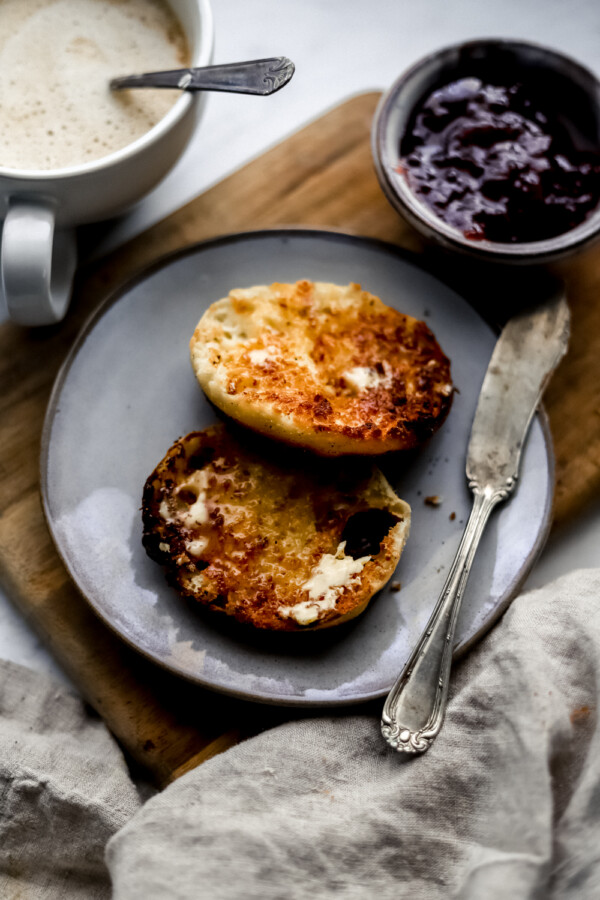
These are The BEST Homemade English Muffins! So simple to make, with foolproof nooks and crannies!
What are English Muffins?
An English muffin is a small, round and flat yeast-leavened bread that is commonly sliced horizontally, toasted, and buttered. English Muffins are usually eaten for breakfast, and are the base for popular breakfast sandwiches, and Eggs Benedict. English Muffins are similar to British Crumpets, but the main difference is that the crumpets are usually more spongy, and English Muffins are more bread-like.
If you’ve never made Homemade English Muffins, you’re in for a real treat! The homemade version is SO much better than the store bought variety. The flavor and soft texture is incredible!
Want more simple bread recipes? Be sure to check out:
Everyday Artisan Bread, Overnight Whole Wheat Sandwich Bread, Easy Sourdough Ciabatta Rolls
Ingredients
- warm water – the ideal temperature for the water is 90 degrees F. You don’t want the water too warm or it will kill the yeast.
- warm milk – Feel free to use whole milk, 2%, or even almond or oat milk for a vegan spin. I’ve had great results with all of them. Just be sure to warm the milk to about 90 degrees F, so that the yeast activation happens faster.
- dry active yeast – my go-to brand of yeast is Red Star. I love the consistent results and high quality. Also, I always store my yeast in the fridge to prolong its shelf life.
- granulated sugar – The sugar int his recipe doesn’t make the English Muffins sweet, it just helps activate the yeast, and helps balance the flavor. Use regular white sugar, not raw or brown sugar.
- kosher salt – I use Morton’s kosher salt in all of my bread recipes. If you are using Diamond Crystal, add another 4 grams of salt.
- unbleached all purpose flour – I use unbleached all purpose flour from King Arthur Baking Company. It has a higher protein content than most AP flours. You could use bread flour if that’s what you have. If you want to add whole grain flour, replace 30g of the total flour amount with the whole grain flour of your choice. Do not substitute the total amount of flour for whole grain flour, as the results will vary greatly, and you English Muffins will be dense.
- avocado oil – I use neutral avocado oil to the dough and to the griddle to cook these English muffins. It’s a cleaner oil, and can safely be heated to high temperatures. It’s also possible to substitute the same amount of melted butter in the dough if you like.
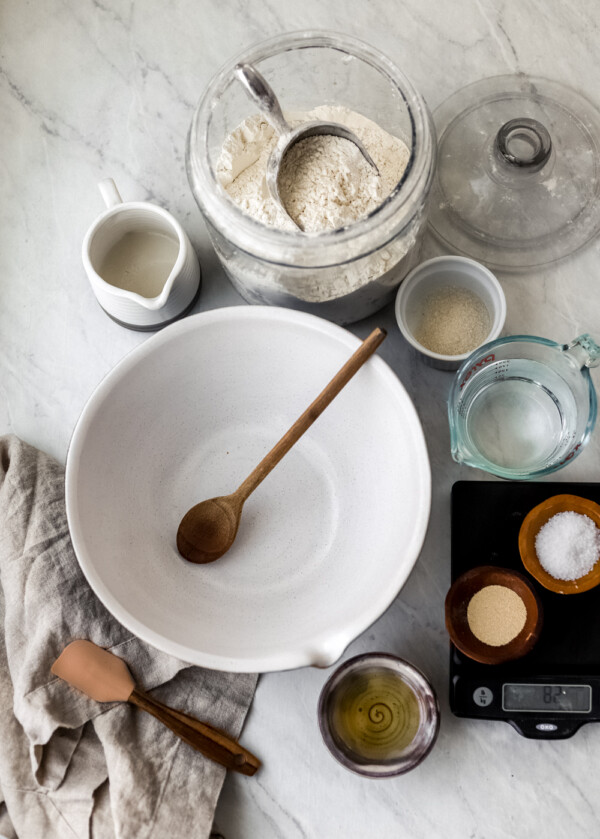
ingredients
How to get more “nooks and crannies”?
As always, I tested this recipes SO many times to get it just right. For me, that meant the maximum amount of nostalgic signature “Nooks and Crannies.” If you’re not sure what I mean, they’re the airy fluffy interior, and air pockets. When toasted, the melted butter usually pools in the nooks and crannies and it’s heavenly!
From my extensive R+D, I found that an overnight rise gave the dough much better flavor, and allowed for proper fermentation. Fermentation is really important when developing the airy crumb of the dough.
Another trick is use a 3-inch round biscuit cutter to cut out the English Muffins. I tried both rolling balls of dough and using a cutter. Both results were incredible, but the cutter method yielded slightly more nooks and crannies. This makes sense because we’re handling dough less, which preserves more of the coveted air bubbles.
Last but not least, use a fork to split the English Muffins in half, NOT A KNIFE! *See section below
Substitutions
As with most bread recipes, I wouldn’t substitute many things. You could substitute the milk for another non-dairy milk. I’ve had success with oat milk and almond milk. You could also substitute the avocado oil for melted butter.
How to make The BEST Homemade English Muffins
Great Homemade English Muffins are super simple to mix up! The dough is mixed up the afternoon/evening before you plan to make these, so plan ahead! The overnight proof is really important to get the proper crumb, fermentation, and air bubbles in the dough.
Start by mixing the water, milk, dry active yeast, and sugar in a large mixing bowl. Whisk and allow the yeast to “wake up” and activate. The sugar helps nourish the yeast and feed it so it’s super active. Then, add the oil, whisk, and the flour and salt. Mix the dough using a wooden spoon. Then pour the dough out onto a very lightly floured work surface. Knead the dough for 2 minutes. Let it sit on the counter for 5 minutes. This autolyse step will give the flour a chance to absorb the liquid, which results in better gluten development, and an easier time of kneading.
Continue to knead the dough for about 8 minutes until the surface of the dough is smooth. Rinse out the bowl, and drizzle about a teaspoon of oil in the bowl. Place the kneaded dough back into the bowl, and cover with plastic wrap. Refrigerate the dough overnight, 12-18 hours.
The next day, remove the dough from the fridge and let stand at room temperature for about 45 minutes. Sprinkle a baking sheet with semolina flour, or finely ground cornmeal. P0ur your dough out onto a floured work surface. Sprinkle the top of the dough lightly with flour, and roll the dough out to 1/2-inch thickness.
Use a 3-inch round cutter to punch out as many English muffins are possible from the dough. Flour the cutter in between each muffin so that it doesn’t stick to the dough. Place the dough round onto the prepared baking sheet. Press the scraps together, and punch out a couple more muffins. You should get 12 English Muffins from this batch of dough. Cover the dough with a damp (not wet) clean kitchen towel to keep the English muffins from drying out. Let the dough proof at room temperature for about 2-3 hours or until puffy and slightly jiggly.
Heat a griddle or cast iron pan on medium/low heat. Drizzle about 1 tablespoon of avocado oil into the pan. Gently place the dough into the pan, and cook for about 4 minutes on the first side. Flip, then cook for another 3-4 minutes on the second side. Check to make sure that the English muffins don’t burn.
Let these Homemade English Muffins cool for at least 10 minutes before slicing them open.
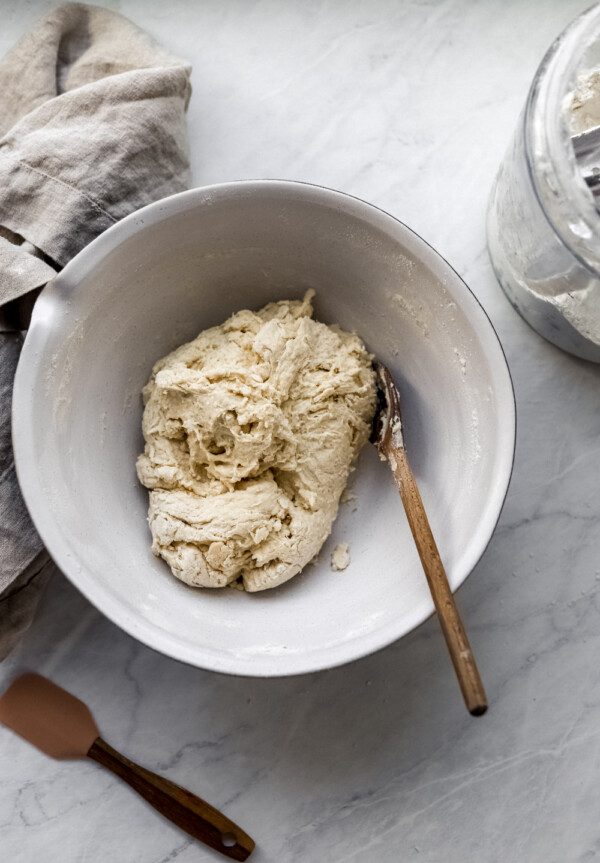
mixed dough
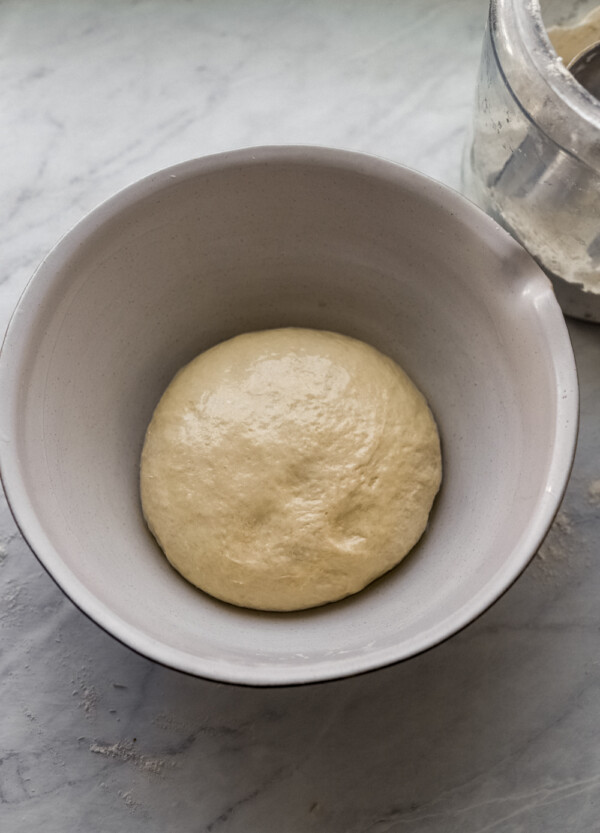
kneaded dough
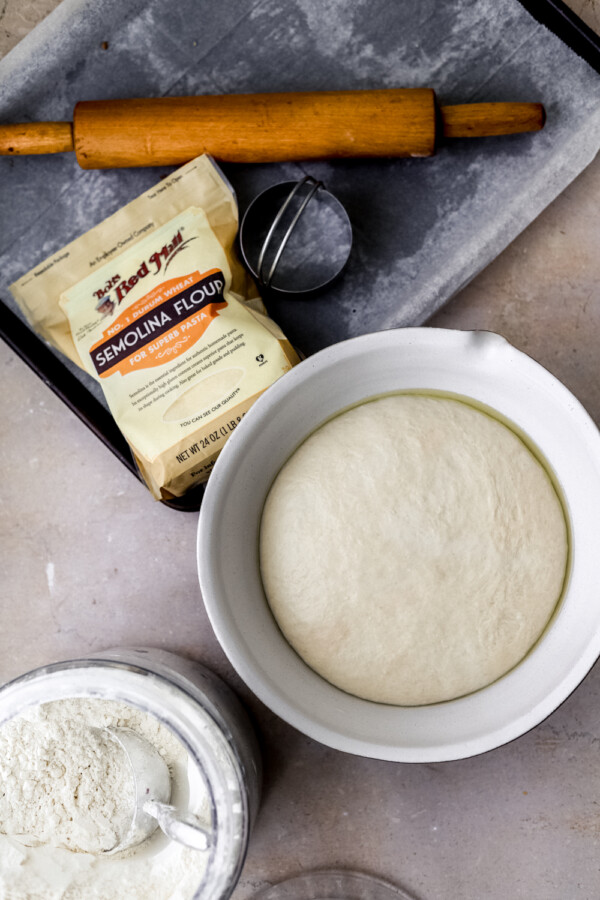
proofed dough
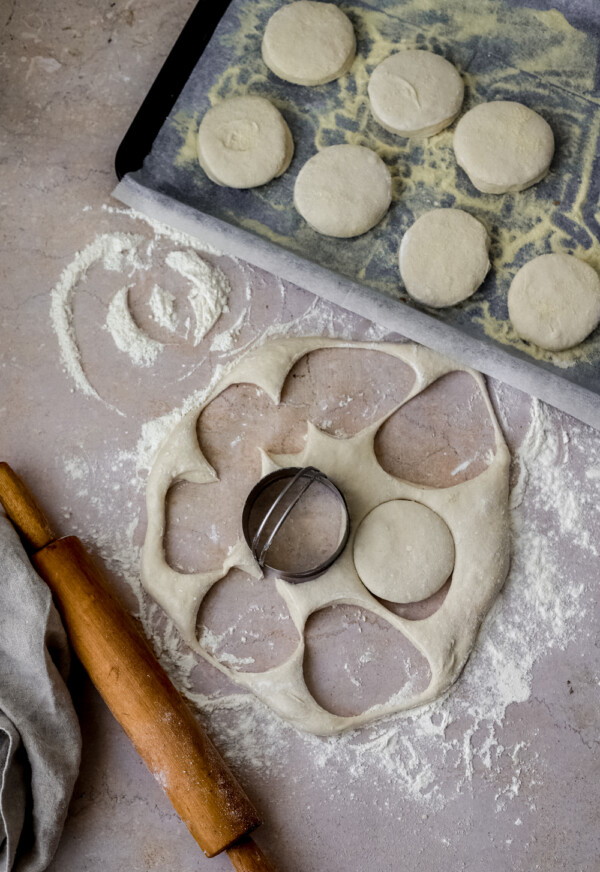
shaped English muffins
How do you cook English Muffins?
This might surprise most of you, but Homemade English Muffins are actually cooked on the stovetop, either on a griddle or in a cast iron pan. I like to coat the pan in a neutral oil, avocado oil is my favorite. Then, the English muffins cook for about 4 minutes per side until they are puffy and soft with toasted sides. After you flip the English muffins, use the back of your spatula to gently press down the english muffins slightly.
What’s the correct way to slice an English Muffin?
People have very strong feelings about this, and rightfully so! The correct way to slice English Muffins in half is by piercing the outer edge with a fork, perforating the equator of the muffin. Then use your hands to gently pull the muffins apart into two halves. Using a fork helps to achieves the craggy edges and desirable nooks and crannies that toast up slightly unevenly, but are so perfect.
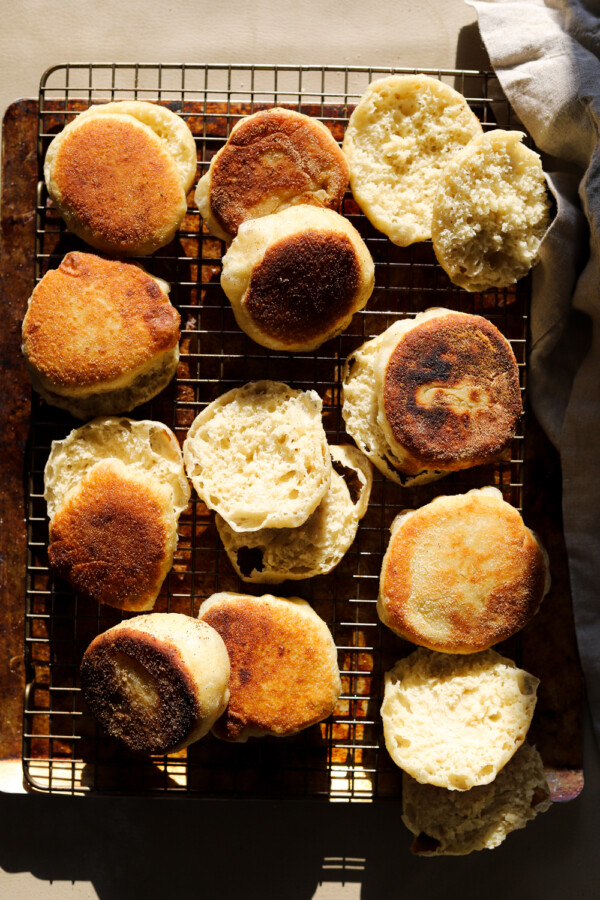
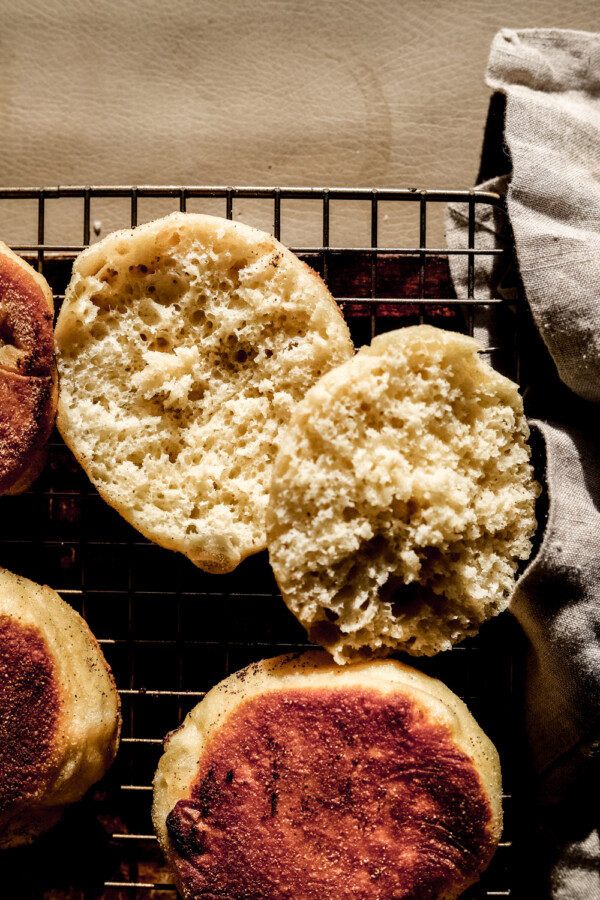
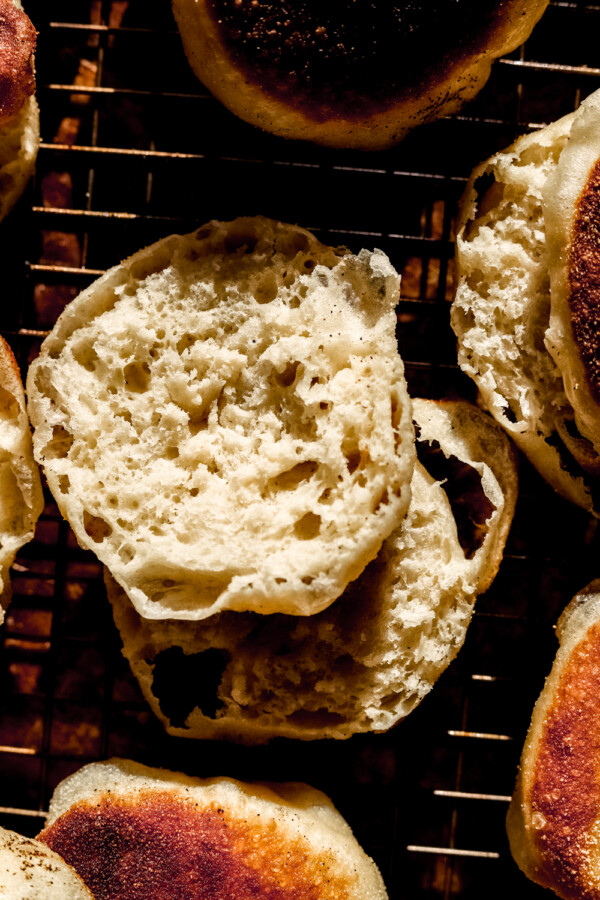
How to Store English Muffins
Like all bread, English Muffins are best eaten the same day they’re made. However, you can store any leftovers in an airtight container or bag at room temperature for up to 3 days. You can also freeze these Homemade English Muffins for up to 1 month. Slice before freezing, and reheat in the toaster.
I can’t wait to see your take on these Homemade English Muffins. Remember to tag me @lions.bread in your pics so I can all of the delicious things you’re making from my site. I love seeing my recipes come to life in your kitchens!
Want save this recipe for later? Just click on the “Pin It” buttons on any of the images to save it to your favorite Pinterest Board.
xo – LeAnne
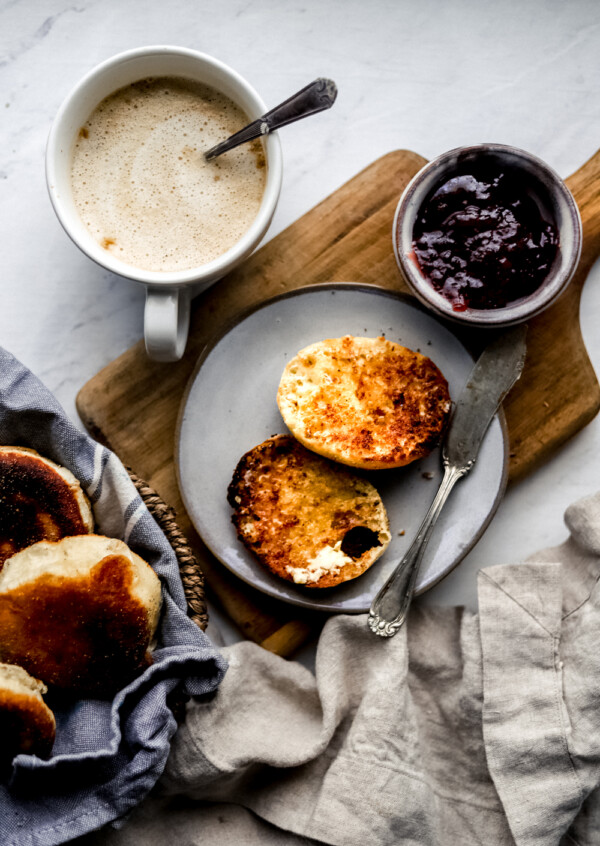

The Best Homemade English Muffins
Ingredients
- 275 g warm water about 90° F
- 75 g warm milk 90°F, or oat/almond milk to make vegan
- 4 g dry active yeast
- 13 g granulated sugar
- 23 g avocado oil
- 515 g unbleached all purpose flour
- 20 g kosher salt I use Morton's
Instructions
- Start by mixing the water, milk, dry active yeast, and sugar in a large mixing bowl. Whisk and allow the yeast to "wake up" and activate. The sugar helps nourish the yeast and feed it so it's super active.
Then, add the oil, whisk, and the flour and salt. Mix the dough using a wooden spoon. Then pour the dough out onto a very lightly floured work surface. Knead the dough for 2 minutes. Let it sit on the counter for 5 minutes. This autolyse step will give the flour a chance to absorb the liquid, which results in better gluten development, and an easier time of kneading.
- Continue to knead the dough for about 8 minutes until the surface of the dough is smooth. Rinse out the bowl, and drizzle about a teaspoon of oil in the bowl. Place the kneaded dough back into the bowl, and cover with plastic wrap. Refrigerate the dough overnight, 12-18 hours.
The next day, remove the dough from the fridge and let it stand at room temperature for 30-45 minutes. Sprinkle a baking sheet with semolina flour, or finely ground cornmeal. Pour your dough out onto a floured work surface. Sprinkle the top of the dough lightly with flour, and roll the dough out to 1/2-inch thickness.
Use a 3-inch round cutter to punch out as many English muffins are possible from the dough. Flour the cutter in between each muffin so that it doesn't stick to the dough. Place the dough round onto the prepared baking sheet. Press the scraps together, and punch out a couple more muffins.
You should get 12 English Muffins from this batch of dough. Cover the dough with a damp (not wet) clean kitchen towel to keep the English muffins from drying out. Let the dough proof at room temperature for about 2-3 hours or until puffy and slightly jiggly.
Heat a griddle or cast iron pan on medium/low heat. Drizzle about 1 tablespoon of avocado oil into the pan. Gently place the dough rounds into the pan, and cook for about 4 minutes on the first side. Flip, then cook for another 3-4 minutes on the second side. Check to make sure that the English muffins don't burn.
Let these Homemade English Muffins cool on a baking rack for at least 10 minutes before slicing them open.
*The post The BEST Homemade English Muffins first appeared on Lion’s Bread Blog.
*This post contains affiliate links. This means that a portion of the proceeds from the sale go to me, at no additional cost to you. Thank you for your continued support that makes Lion’s Bread possible.


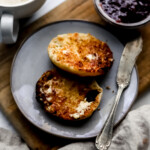
Mila says
Hello,
Can you tell me why I can’t use raw cane sugar if it’s just for activating the yeast?
Thank you.
LeAnne says
Hi Mila,
I think using raw cane sugar for activating the yeast is totally fine! Just make sure to stir it well enough that it completely dissolves.
Hope you love them!
LeAnne